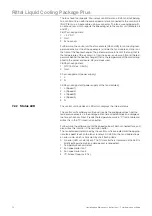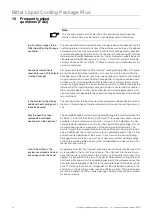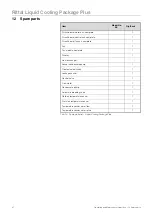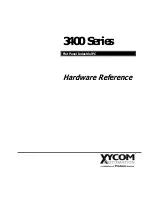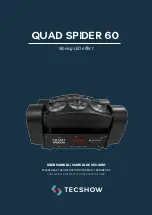
81
Operating and Maintenance Instructions – 10 Frequently asked questions (FAQ)
Rittal Liquid Cooling Package Plus
10
Frequently asked
questions (FAQ)
In what output ranges is the
Rittal Liquid Cooling Package
available?
The cooling output of an air/water heat exchanger is basically dependent on the
inlet temperature and volumetric flow of the water as well as the air throughput
achieved by the fans which are used. Up to 30 kW of cooling output is possible.
In correctly assessing the information, it is important to note at what
Δ
T (at what
temperature differential between server air inlet and server air outlet) these val-
ues were reported. Modern servers such as 1 U Dual CPU systems or blade
servers can have a
Δ
T of up to 25 °C. Please note the recommendations of the
server manufacturer.
Are special components
required for use with the Liquid
Cooling Package?
All components that follow the "front to back" cooling principle (99% of IT equip-
ment) may be used without restriction in connection with the Liquid Cooling
Package. Every Rittal server rack which was previously cooled conventionally
may be cooled with a Liquid Cooling Package after changing to sealed doors.
In other words, it is possible to retrofit standard racks and bay them onto the
Liquid Cooling Package. The server enclosure remains unaffected by the side
installation of the Liquid Cooling Package. All height units remain fully usable in
their complete depth. Further, by locating the foam strips appropriately, suffi-
cient cooling is also possible for devices which require sideways air throughput
(e.g. switches).
Is the ambient air heated by
additional heat coming out of
these enclosures?
The cooling system in the enclosure works completely independently of the am-
bient air. All waste heat is transferred externally through the cooling water cir-
cuit.
May the quantity of heat
removed be controlled
dependent on the heat loss?
The controlled variable for the Liquid Cooling Package is the temperature of the
air blown in in front of the 482.6 mm (19") level. The values to be used here are
available in the manufacturer's instruction manual. Upon installation, the de-
sired setpoint temperature is set once on the Liquid Cooling Package. This val-
ue will be kept constant, irrespective of the cooling output demands. This
occurs through the corresponding automatic opening and closing of the ball
valve. Additionally, the necessary fan output is adjusted based on the air inlet
and exhaust temperatures of the server. In this manner, the Liquid Cooling
Package always cools only as much as is necessary without wasting energy.
Further, this avoids problems arising from condensation and desiccation which
results from overcooling.
How is the airflow in the
enclosure achieved and what
advantages does this have?
As a general rule, the "front to back" principle is used in server enclosures. Cold
air is supplied to the front of the enclosure. The units built into the enclosure
have their own fans, which draw in this air and use it internally for cooling. Thus
heated, it is exhausted to the rear. The special horizontal air routing of the Liq-
uid Cooling Package, which is adapted especially to this widespread cooling
principle, evenly supplies cooled air to the complete height of the server enclo-
sure. That means that all units, independent of their installation position in the
enclosure and their charge state, receive sufficient cold air. Temperature gra-
dients are avoided, so that an extremely high cooling output can be achieved
for each enclosure.
Note:
This chapter contains only a selection of the frequently asked questions
(FAQ). Further FAQs may be found on our website: www.rimatrix5.com









